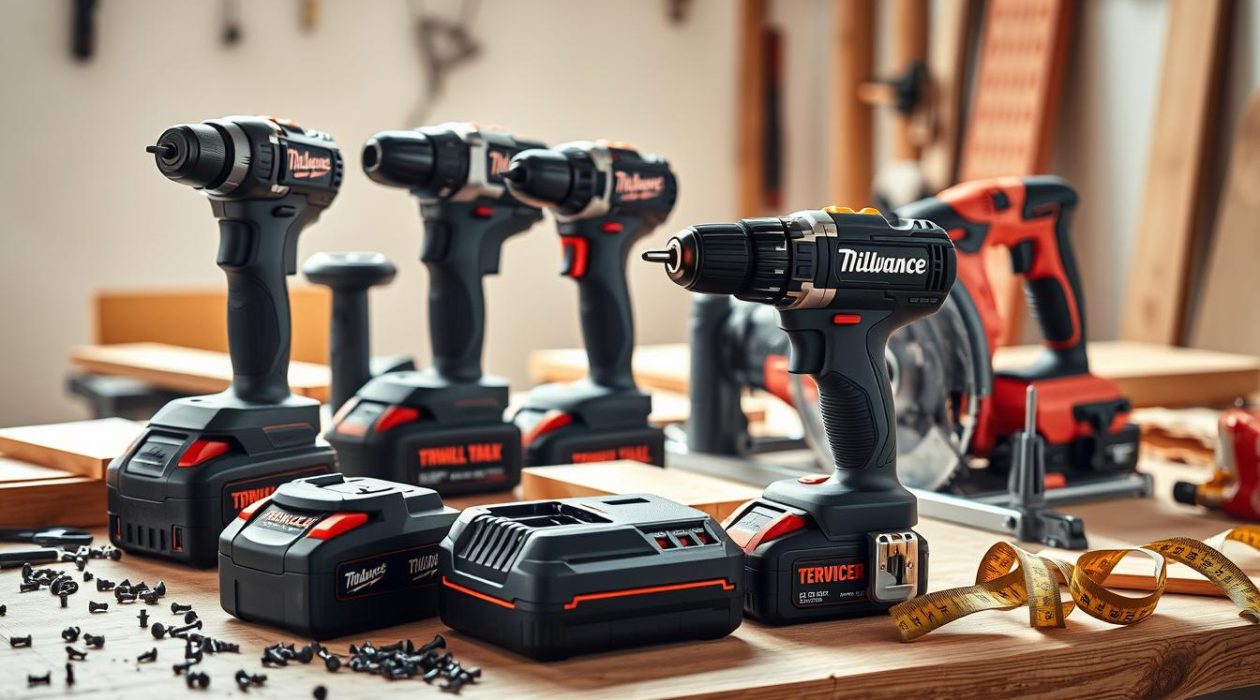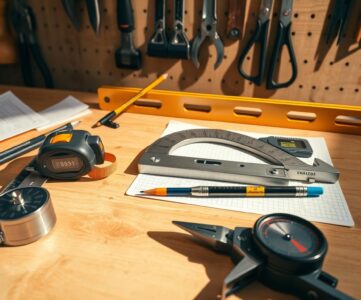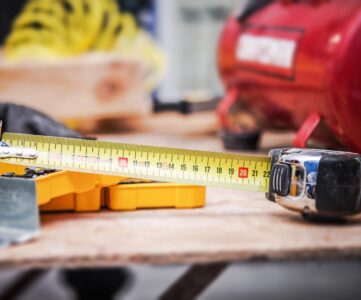When selecting tools for DIY projects and home improvements, you face a choice between cordless and corded tools. Cordless tools, including power tools, offer mobility and convenience. This article will help you understand the differences between these two types, aiding in your decision-making process.
Cordless tools, such as power tools, have gained popularity for their ease and flexibility. Knowing the advantages and disadvantages of each type allows you to select the most suitable option for your needs.
Key Takeaways
- Cordless tools offer increased mobility and convenience
- Cordless power tools are ideal for DIY projects and home improvements
- Understanding the pros and cons of each type of tool is crucial for making an informed decision
- Cordless tools provide a range of benefits, including ease of use and flexibility
- Cordless power tools are a popular choice for many homeowners and professionals
- Cordless tools are a great option for those who value convenience and mobility
What Makes Cordless Tools Different from Traditional Power Tools
Cordless power tools have transformed DIY projects and home improvements. Their power source, rechargeable batteries, offers unmatched mobility and convenience. This distinguishes them from traditional power tools.
In tool comparison, cordless tools stand out. They are lighter and more compact, enhancing ease of use and maneuverability. Their ergonomic design and lightweight construction further boost their mobility features.
Power Source Technology
Advanced battery technology powers cordless tools, ensuring a reliable and consistent energy supply. This technology has evolved, making cordless tools suitable for demanding tasks.
Basic Operating Principles
Cordless tools operate on the same principles as traditional power tools but offer the added benefit of cordless operation. They deliver high performance and efficiency, making them versatile for various tasks.
The main advantage of cordless power tools is their mobility and convenience. They are perfect for situations where traditional tools are impractical. Thanks to technological advancements, cordless tools are now favored by both DIY enthusiasts and professionals.
The Evolution of Modern Cordless Tools
Cordless tools have seen major changes, becoming more powerful, efficient, and affordable. These improvements stem from advancements in battery tech, motor design, and ergonomic features. Now, DIY cordless tools are favored for their ability to handle various projects with ease and accuracy.
Better battery tech is a crucial factor, offering longer use and quicker charging. This complexity in tool comparison means users must weigh power, performance, battery life, and charging speed. Brands like DeWalt and Makita have introduced groundbreaking battery technologies, setting new benchmarks.
For DIY cordless tools, users seek tools that are user-friendly, versatile, and budget-friendly. Key aspects to consider in tool comparison include:
- Power and performance
- Battery life and charging time
- Ergonomic design and comfort
- Price and value
In summary, the evolution of cordless tools has been swift and profound, fueled by technological and design advancements. As the market expands, understanding the critical factors in tool comparison is vital. This ensures making well-informed choices when selecting DIY cordless tools for your endeavors.
Power and Performance Comparison
When evaluating cordless power tools, it’s crucial to consider their power and performance capabilities. A thorough tool comparison can help you determine which cordless tools meet your specific needs and applications. In recent years, cordless tools have made significant strides in terms of power and performance, making them a viable alternative to traditional corded tools.
A key factor in power and performance is the tool’s ability to deliver consistent torque and speed. Cordless power tools have improved significantly in this area, with many models offering adjustable torque and speed settings. This allows users to customize the tool’s performance to suit their specific task or material.
Torque and Speed Analysis
When analyzing the torque and speed of cordless power tools, it’s crucial to consider the tool’s runtime considerations and power consistency factors. A tool with high torque and speed capabilities may not be effective if its runtime is limited or its power output is inconsistent. A balanced approach to power and performance is essential for achieving optimal results.
Runtime Considerations
Runtime considerations are critical when evaluating cordless power tools. A tool with a long runtime can increase productivity and reduce downtime. Many cordless power tools now offer advanced battery technology, providing longer runtime and faster charging times. When comparing cordless tools, consider the runtime and charging time to ensure you choose a tool that meets your needs.
By considering these factors and conducting a thorough tool comparison, you can make an informed decision when selecting cordless power tools for your specific applications. Whether you’re a professional or a DIY enthusiast, choosing the right cordless power tools can help you achieve optimal results and increase your overall productivity.
Battery Technology and Management
In the realm of DIY cordless tools, battery technology is key to their performance and efficiency. Recent advancements have led to more efficient and durable batteries. This has made cordless power tools a favorite among both professionals and DIY enthusiasts.
Effective battery management is vital for optimal performance and longer battery life. This includes proper charging and maintenance, such as avoiding overcharging and keeping batteries clean. By following these tips, users can maximize their DIY cordless tools and enjoy extended battery life.
Some key benefits of proper battery management include:
- Increased battery life
- Improved performance
- Reduced maintenance costs
As technology advances, we can look forward to even more efficient and powerful batteries for cordless power tools. This will benefit both professionals and DIY enthusiasts who depend on these tools for their projects. With the right battery technology and management, DIY cordless tools become a reliable and efficient choice for any task.
Cost Analysis: Initial Investment vs. Long-term Value
In the realm of tool comparison, the initial cost is merely the starting point. To grasp the true worth of DIY cordless tools, one must evaluate long-term expenses. This includes ongoing operational costs and replacement fees.
The cost analysis hinges on comparing the purchase prices of cordless and corded tools. Cordless tools, though pricier at first, offer unmatched mobility and convenience. This makes them a valuable investment for both DIY enthusiasts and professionals.
Purchase Price Comparison
- Cordless tools: higher initial investment, but greater mobility and convenience
- Corded tools: lower upfront cost, but limited by cord length and availability of power outlets
When considering DIY cordless tools, it’s crucial to factor in operating costs over time. This includes the expense of batteries and other consumables. Yet, many cordless tools boast energy-efficient designs and long-lasting batteries. These features can significantly reduce long-term costs.
Operating Costs Over Time
Understanding the total cost of ownership is key. This includes both the initial investment and long-term expenses. By doing so, individuals can make informed choices about their tool comparison. They can select the most suitable options for their needs and budget.
Practical Applications in Home Improvement
Cordless power tools have become crucial in home improvement, offering greater mobility and less fatigue. They come in a variety of tools, enabling homeowners to handle tasks like drilling, sawing, sanding, and more.
In tool comparison, cordless power tools stand out for their ease of use and safety. They are widely used in home improvement for tasks such as:
- Drilling and driving screws
- Sawing and cutting wood
- Sanding and polishing surfaces
- Grinding and polishing metal
Using cordless power tools makes projects more efficient and effective. For instance, a cordless drill is perfect for drilling holes and driving screws in tight spots. A cordless saw makes cutting wood and other materials straightforward.
Cordless power tools also provide a cost-effective option for home improvement. By investing in a cordless tool set, homeowners can save money and complete projects easily.
Cordless power tools have revolutionized home improvement, offering increased mobility, reduced fatigue, and improved safety.
| Tool | Application | Benefit |
|---|---|---|
| Cordless Drill | Drilling and driving screws | Increased mobility and ease of use |
| Cordless Saw | Sawing and cutting wood | Improved safety and reduced fatigue |
| Cordless Sander | Sanding and polishing surfaces | Increased efficiency and effectiveness |
Durability and Lifespan Expectations
Durability and lifespan are key when choosing DIY cordless tools. A sturdy cordless power tool can handle frequent use for years. The quality of its construction greatly influences its lifespan.
Cordless power tools are designed to be compact and lightweight. This makes them easy to use but also requires careful engineering of internal components. Build quality differences between cordless and corded tools significantly affect their lifespan.
Factors Affecting Lifespan
- Environmental factors like extreme temperatures or moisture can shorten a cordless tool’s lifespan.
- Regular maintenance, including cleaning and lubrication, is crucial for optimal performance and longevity.
- Proper storage and handling techniques can prevent damage and extend the tool’s lifespan.
Understanding these factors and maintaining your cordless tools properly can ensure a long, reliable lifespan. This is true for both DIY cordless tools and cordless power tools.
Professional vs. DIY Usage Considerations
When it comes to cordless power tools, professionals and DIY enthusiasts have different needs. Professionals need tools that can handle heavy use and perform consistently. On the other hand, DIYers often look for tools that are easy to use and affordable. A detailed tool comparison is key to finding the best tools for various tasks.
In a tool comparison, power, precision, and durability are critical. Professionals might choose cordless power tools with high torque and speed. DIYers, by contrast, might prefer tools with lower power but are easier to use. Knowing these differences is essential for picking the right tool.
Some important factors to consider include:
- Power output and speed
- Precision and accuracy
- Durability and lifespan
- Ease of use and maintenance
By examining these factors and conducting a thorough tool comparison, individuals can make informed choices. This ensures they select the most suitable cordless power tools for their needs.
Storage and Portability Benefits
DIY cordless tools offer significant advantages in storage and portability. Their compact and lightweight design makes them easy to store and transport. This is crucial for professionals and DIY enthusiasts working on various projects at different locations.
The tools’ compact design allows for space-saving solutions. This makes it easier to store them in a workshop or garage. Their lightweight construction also reduces the risk of damage during transport. With cordless power tools, carrying them to and from the jobsite is hassle-free, without the need for cords or bulky equipment.
Space-saving Solutions
Cordless tools provide a range of space-saving solutions, including:
- Compact chargers and batteries
- Toolboxes and cases with custom compartments
- Wall-mounted storage systems
These solutions help keep your cordless power tools organized and within reach. This makes it easier to work on projects efficiently.
Transportation Factors
Transporting cordless power tools is convenient due to their lightweight design and compact size. You can easily carry them in a toolbox or bag, reducing the risk of damage. With cordless power tools, you can work on projects anywhere, without being limited by cords or bulky equipment.
Safety Features and Considerations
When examining cordless power tools, safety is paramount. A detailed tool comparison must assess each tool’s safety features and considerations. This encompasses protective gear, correct usage techniques, and maintenance needs.
Common dangers with cordless tools include electrical shock and physical injury. To mitigate these risks, adhering to the manufacturer’s guidelines is crucial. Here are key safety tips to remember:
- Wear protective gear, such as gloves and safety glasses
- Use the correct battery and charger for your tool
- Avoid overloading the tool or using it in extreme temperatures
Understanding the safety aspects of cordless power tools is vital for a safe tool comparison process. Always follow the manufacturer’s instructions and take precautions to avoid injury or damage.
Conclusion: Making the Right Choice for Your Needs
The decision between cordless and corded power tools hinges on your specific needs and preferences. Cordless tools are favored for their mobility and lack of cords, making them ideal for DIY enthusiasts and home improvement tasks. Yet, corded tools often deliver consistent power and longer runtime, crucial for heavy-duty tasks.
When picking a cordless tool, assess battery life, power output, and compatibility with your current tool set. Brands like DEWALT and Makita are renowned for their top-notch cordless power tools, ensuring reliable performance. It’s essential to weigh the pros and cons to find the cordless tool that meets your needs and budget.
Both cordless and corded power tools can significantly enhance your toolbox, enabling you to handle a variety of home improvement and DIY projects confidently. By grasping the benefits of each, you can make a well-informed choice, improving your overall experience with power tools.






